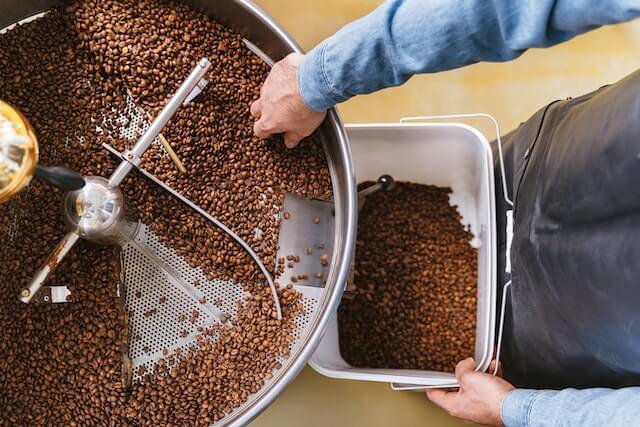Roasted Coffee
As suppliers of roasted coffee beans, we receive numerous emails through our website, covering a wide range of questions about roasted coffee.
These inquiries typically come from two types of customers. The first group consists of coffee enthusiasts who are interested in starting a business but have limited knowledge about coffee. Their questions revolve around basic concepts. The second group includes individuals or companies seeking specific information about our products and services. They are generally looking for higher quality coffee with specific roasting profiles.
Since the questions we receive are often repetitive, we have decided to address them in this article. Here, we will explain the fundamentals of roasted coffee for the first group of customers and provide answers to the most frequently asked questions about our services for the second group.
If you belong to the first group and are interested in discovering more about roasted coffee, please proceed with reading. Alternatively, if you wish to explore information regarding our products and services, kindly click here.
What is roasted coffee?
Roasted coffee refers to coffee beans that have undergone the roasting process. Roasting is a crucial step in the coffee production process that transforms raw, green coffee beans into the familiar brown, aromatic, and flavourful beans used to make coffee.
During the roasting process, green coffee beans are heated to high temperatures, typically ranging from 370°F to 540°F (188°C to 282°C). The heat causes various chemical reactions within the beans, leading to physical and chemical changes that bring out the desirable flavours, aromas, and characteristics of the coffee.
Roasting coffee beans involves three key stages:
- Drying: At the beginning of the roasting process, the moisture content of the beans is reduced through evaporation. This stage is important to prepare the beans for subsequent chemical reactions and to prevent the beans from steaming or popping during the roast.
- Browning: As the roasting temperature increases, the coffee beans undergo a series of complex chemical reactions. The beans gradually change color, from green to yellow, and then to shades of brown. This browning stage is where the coffee develops its characteristic flavours, aromas, and caramelisation.
- Development: During this stage, the coffee beans continue to undergo chemical changes that further develop their flavours. The roaster carefully controls the time and temperature to achieve the desired roast level, which can vary from light to medium to dark. Each roast level offers distinct characteristics, with lighter roasts generally retaining more of the beans’ original flavours and acidity, while darker roasts tend to have bolder and more pronounced flavours.
The roasting process significantly affects the taste, aroma, and overall profile of the coffee. Different roast levels produce different flavour profiles, ranging from fruity and acidic to chocolaty and smoky. The roasting process also affects the caffeine content of the beans, with lighter roasts generally containing slightly more caffeine than darker roasts.
We highly recommend watching this informative video by James Hoffmann. He provides a clear and accessible explanation of the roasting process, as well as the various types of roasting machines available in the market.
Is coffee roasting difficult?
Coffee roasting can be both a straightforward process and a complex skill to master, depending on the level of precision and expertise desired. Here are some key factors to consider regarding the difficulty of coffee roasting:
- Basic Roasting: The basic process of roasting coffee involves applying heat to green coffee beans to transform them into roasted beans. This can be done using various methods, including home roasters, stovetop popcorn poppers, or even a skillet. These methods typically require monitoring the heat and time to achieve a desired roast level.
- Skill Development: While the basic roasting process is accessible to beginners, developing a deep understanding of the roasting process and consistently producing high-quality roasts can be challenging. Achieving desired flavour profiles requires learning about variables like temperature, airflow, bean density, and timing. It takes practice and experimentation to refine one’s skills.
- Sensory Evaluation: Roasting involves sensory evaluation, such as observing changes in color, listening for the “first crack” and “second crack” sounds, and assessing aroma development. Developing a keen sense of smell, taste, and visual cues requires training and experience.
- Consistency: Roasting coffee consistently, batch after batch, is another aspect that can be challenging. Factors like batch size, environmental conditions, and machine capabilities can influence consistency. Roasters often fine-tune their processes, adjust variables, and keep detailed records to replicate successful roasts.
- Continuous Learning: Coffee roasting is a continuous learning process. Roasters stay updated on industry trends, roast profiles for different coffee origins and varieties, and the evolving understanding of the chemical reactions occurring during roasting. Ongoing education and staying abreast of new developments in the field are important for refining skills.
While coffee roasting can be challenging, it’s also a creative and rewarding pursuit. Many coffee professionals find joy in experimenting with different roast profiles, unlocking unique flavours, and sharing their craft with others. With dedication, practice, and a passion for coffee, individuals can develop their roasting skills over time.

Where can you learn to roast coffee?
There are several avenues where you can learn to roast coffee. Here are some popular options:
- Specialty Coffee Associations: Various specialty coffee associations, such as the Specialty Coffee Association (SCA) and its global network of chapters, offer educational programs and certifications related to coffee, including coffee roasting. These programs often cover the fundamentals of roasting, roast profiling, equipment operation, and sensory evaluation.
- Roasting Classes and Workshops: Many coffee training centers, coffee schools, and specialty coffee companies offer roasting classes and workshops. These hands-on sessions provide practical training on operating coffee roasters, understanding roast profiles, and developing sensory skills. Look for local coffee education providers or check with coffee roasters in your area for any available workshops.
- Online Courses and Webinars: There are numerous online courses and webinars that focus on coffee roasting. These courses often provide in-depth video lessons, educational materials, and assignments that can be completed at your own pace. Some platforms, such as the SCA’s Coffee Skills Program, offer online modules specifically for coffee roasting.
- Apprenticeships and Mentorships: Connecting with experienced coffee roasters and seeking apprenticeships or mentorship opportunities can be a valuable way to learn the art of roasting. By working alongside seasoned professionals, you can gain practical insights, receive guidance, and learn from their expertise.
- Industry Events and Conferences: Attending industry events and conferences, such as coffee trade shows or specialty coffee conventions, can offer opportunities to learn from experts and participate in workshops or seminars focused on coffee roasting. These events often bring together roasters, equipment suppliers, and industry leaders who share insights and knowledge.
- Books and Online Resources: There are many books, online forums, blogs, and resources available that delve into the science, techniques, and artistry of coffee roasting. Some recommended books include “The Coffee Roaster’s Companion” by Scott Rao, “Modulating the Flavour Profile of Coffee” by Rob Hoos, and “The Professional Barista’s Handbook” by Scott Rao (which covers roasting among other topics).
Remember, coffee roasting is a skill that requires hands-on practice and experience. Combining formal education with practical application will help you develop your roasting abilities. Additionally, networking with the coffee community, attending cupping sessions, and engaging in discussions with other coffee professionals can contribute to your learning journey.
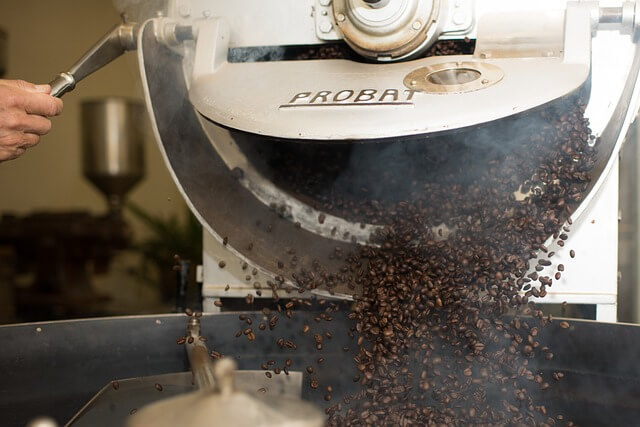
How much does a coffee roasting machine cost?
The cost of a roasting coffee machine can vary depending on various factors such as brand, size, capacity, features, and overall quality. There is a wide range of roasting machines available, from small home roasters to commercial-grade ones used by coffee shops and larger-scale operations.
For larger commercial roasting machines used by coffee shops, specialty roasters, or industrial-scale operations, the prices can start from $15,000 and go well above $50,000. These machines have higher capacities, advanced automation features, and are built to handle larger production volumes.
It’s important to note that these price ranges are approximate and can vary significantly based on the specific brand, model, and additional features you might need.
Choosing the right coffee roasting machine for your specialty coffee shop requires careful consideration of several factors. Here are some key points to help you make an informed decision:
- Roasting Capacity: Evaluate the expected demand and volume of your coffee shop. Consider the number of customers you anticipate serving and how much coffee you’ll need to roast daily. This will help you determine the appropriate batch size and roasting capacity required for your machine.
- Control and Automation: Decide the level of control and automation you prefer. Some roasting machines offer manual control, allowing you to adjust variables like temperature and time, while others have more advanced automation features.
- Consistency and Precision: Look for a roasting machine that provides consistent results and precise control over the roasting parameters. Consistency is crucial for maintaining the quality and flavour profile of your specialty coffees.
- Profile Customisation: If you plan to experiment with different roast profiles, seek a machine that allows customisation and storage of roast profiles. This feature enables you to fine-tune the roasting process to achieve specific flavours and characteristics.
- Size and Space: Consider the physical dimensions of the roasting machine and ensure it fits within your available space. Measure the area where you plan to install the machine to avoid any space constraints or logistical issues.
- Budget: Determine your budget range for the roasting machine. As mentioned earlier, prices can vary significantly. Set a budget that aligns with your financial capacity and shop’s requirements.
- Research and Reviews: Read reviews, seek recommendations from other coffee professionals, and do thorough research on different brands and models. Look for machines with a good reputation for reliability, durability, and customer support.
- Training and Support: Consider the availability of training and technical support provided by the manufacturer or supplier. Proper training is essential to operate the roasting machine effectively and maintain its performance.
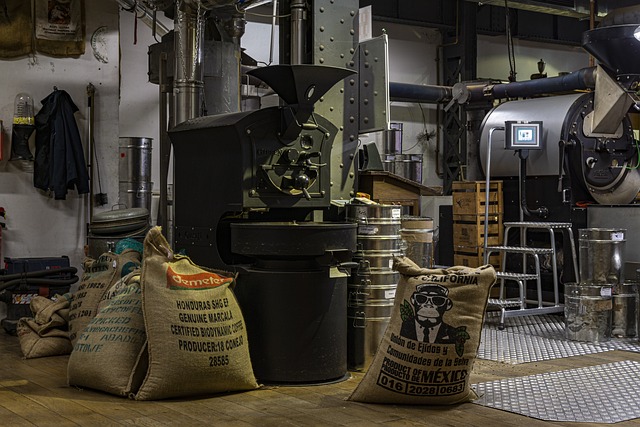
It’s always a good idea to speak to a professional coffee roaster with lots of experience who can give you advice and can help you find the right roasting machine for your needs and budget.
Here’s some information about different types of roasting machines commonly used in the coffee industry:
- Drum Roasters: Drum roasters are the most traditional and widely used roasting machines. They consist of a rotating drum where the coffee beans are heated evenly. The drum rotates to ensure that the beans are exposed to consistent heat throughout the roasting process. Drum roasters offer good control over the roasting variables such as time, temperature, and airflow, allowing roasters to develop specific flavours and profiles. They are suitable for both small-scale artisanal roasters and larger commercial operations.
- Fluid Bed Roasters: Fluid bed roasters, also known as hot air roasters or air roasters, use a column of hot air to roast coffee beans. The beans are suspended in a stream of hot air, allowing for efficient and rapid heat transfer. The hot air keeps the beans in constant motion, ensuring even roasting. Fluid bed roasters are known for their ability to produce bright and vibrant flavors, particularly in light to medium roasts. They are often used in specialty coffee shops and small-scale roasting operations.
- Centrifugal Roasters: Centrifugal roasters are a relatively newer type of roasting machine. They use centrifugal force to agitate and roast the coffee beans. The beans are placed in a rotating chamber where heated air is forced through them, ensuring uniform heat distribution. Centrifugal roasters offer precise control over temperature and airflow, allowing for consistent and customisable roasting profiles. They are commonly used in large-scale commercial coffee production.
- Hybrid Roasters: Hybrid roasters combine different roasting technologies to achieve specific outcomes. These machines incorporate elements of drum roasting, fluid bed roasting, and other innovative techniques. Hybrid roasters offer the advantages of multiple roasting methods, allowing roasters to experiment and create unique flavour profiles. They are often used by specialty coffee roasters who aim to push the boundaries of coffee roasting.
- Sample Roasters: Sample roasters are specifically designed for small-batch roasting, typically used for quality control and sample production purposes. They allow roasters to evaluate the flavor, aroma, and characteristics of different coffee beans before scaling up for larger production. Sample roasters come in various sizes and designs, ranging from small countertop models to larger capacity machines.
It’s worth noting that each type of roasting machine has its advantages and characteristics, and the choice of machine depends on factors such as the scale of operations, desired flavour profiles, and budget constraints. Coffee roasters often develop their own preferences and expertise with a particular type of roasting machine based on their unique roasting goals and requirements.
Remember, regardless of the type of roasting machine used, the skill, knowledge, and experience of the coffee roaster play a significant role in achieving exceptional roasted coffee.
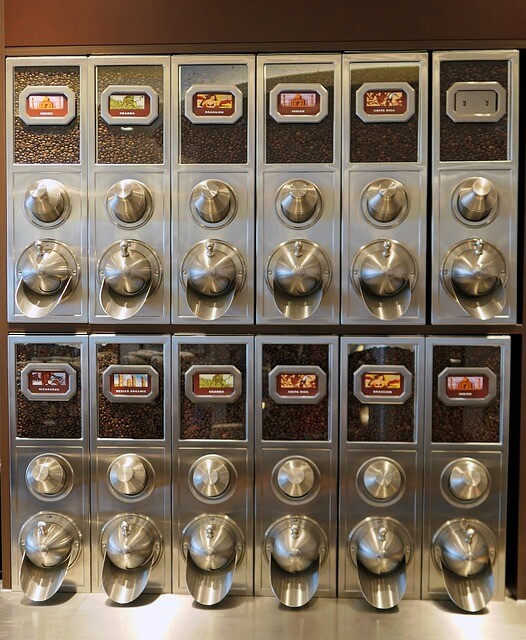
How do you store fresh roasted coffee beans?
To store fresh roasted coffee beans and preserve their freshness, follow these guidelines:
- Use an Airtight Container: Transfer the roasted coffee beans to an airtight container, preferably one with a valve. The valve allows excess carbon dioxide to escape while preventing oxygen from entering. This helps preserve the flavours and aromas of the beans.
- Avoid Light and Moisture: Store the coffee beans in a cool, dry place away from direct sunlight, as light can degrade the quality of the beans over time. Additionally, exposure to moisture can cause the beans to spoil or lose their freshness more quickly.
- Protect from Air Exposure: Oxygen is one of the primary factors that contribute to the staling process of coffee beans. Make sure the container used for storage is airtight and provides a good seal, minimising air exposure to the beans.
- Avoid Strong Odors: Coffee beans are porous and can absorb odors from their surroundings. Store them away from strong-smelling substances to prevent the beans from taking on unwanted flavours.
- Optimal Temperature: Coffee beans should be stored at a moderate temperature, ideally between 20°C and 25°C (68°F and 77°F). Avoid extreme heat or cold, as they can negatively impact the quality and freshness of the beans.
- Purchase in Smaller Quantities: It’s generally recommended to buy coffee beans in smaller quantities to ensure you consume them within a reasonable time frame.
By following these storage practices, you can extend the freshness and quality of your roasted coffee beans.
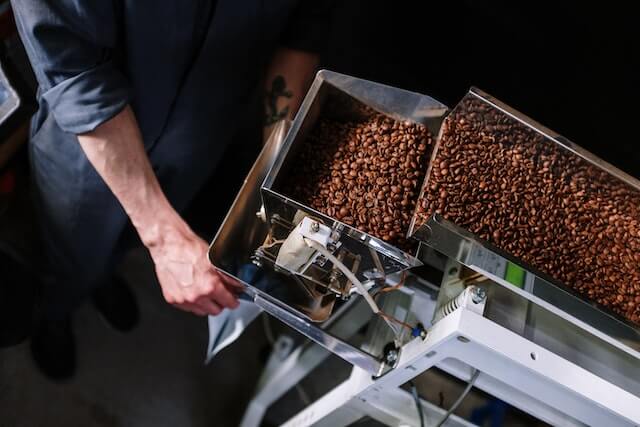
What are the pros and cons of buying roasted coffee?
Pros:
- Convenience: Buying roasted coffee is convenient since the beans are ready to use. You don’t need any additional equipment or expertise.
- Wide Variety: There is a vast selection of roasted coffee available from different origins, blends, and roast levels. You can explore and try different flavors and profiles.
- Time and Effort Saved: Roasting coffee requires time, attention, and equipment. By buying roasted coffee, you save yourself the effort and commitment required for roasting coffee.
- Consistent Results: Roasted coffee from reputable roasters often provides consistent and reliable results in terms of flavor, aroma, and quality. You can expect a certain level of craftsmanship and expertise in the roasting process.
Cons:
- Limited Control: When you buy roasted coffee, you have limited control over the roast level and freshness of the beans. The coffee may not align perfectly with your personal taste preferences.
- Less Freshness: Even if you purchase freshly roasted coffee, it will still have undergone some degree of aging and degradation compared to coffee roasted and consumed immediately.
- Dependency on Suppliers: Your access to quality roasted coffee depends on the availability and reliability of coffee roasters in your area or the online market. Limited options may be available locally.
- Cost: Buying roasted coffee can be more expensive in the long run compared to green coffee beans. The costs associated with the roasting process, packaging, and distribution are factored into the price.
These factors should help you consider the pros and cons of purchasing green coffee beans and roasted coffee beans. Green coffee beans offer greater control over the roasting process, allowing you to customize the flavour profiles to your preference. They also have a longer shelf life, allowing for more flexibility in inventory management. However, they require a coffee roaster and advanced roasting skills.
The above are the commonly asked questions from individuals who are new to the coffee industry and are aspiring to start their own business. Kindly inform us if there are any significant questions we may have overlooked.
Now let’s address the questions from companies and individuals who are looking for a supplier of roasted coffee who can meet their expectations.
Can you send us free roasted coffee samples?
We are pleased to inform you that we offer the provision of complimentary samples of our diverse range of coffee varieties. We understand the importance of experiencing our products firsthand before making a purchasing decision. Rest assured, there is no cost associated with the coffee samples themselves. However, we kindly request that you bear the shipping expenses through our trusted shipping partner, DHL Express.
Can you roast the coffee according to our specifications?
While our Colombian coffees are traditionally lightly roasted to enhance the inherent flavours of their origin, we are committed to accommodating your specific preferences. We recognise that a distinct roast profile can set you apart from your competitors. Thus, we are more than capable of customising the roasting process to align with your desired specifications.
Can you pack the coffee in bags with our own brand?
We are delighted to offer comprehensive packaging solutions tailored to your brand requirements. Our team is fully equipped to handle the entire packaging design and printing process, or alternatively, we can package the coffee using the materials you provide us.
What are the different types of pack sizes available?
To cater to diverse needs, we offer a wide range of bag sizes for packaging our premium coffee. Our options include 250g, 500g, 1kg, 2.5kg, 5kg, as well as larger 60kg and 70kg bags.
Is there a minimum purchase quantity?
When placing coffee orders with customised bags, a minimum quantity of 6,500 kilos is required. However, for orders with white label bags, there is no minimum quantity restriction.
We hope this article has answered the questions most people ask about roasted coffee and how we supply it. If there’s anything else you want to know or if you have any concerns, please don’t hesitate to tell us. We’re eager to hear your thoughts and comments.

